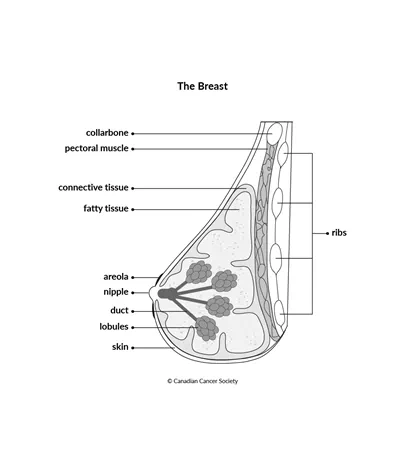What is breast cancer?
Breast cancer starts in the cells of the breast. A cancerous (malignant) tumour is a group of cancer cells that can grow into and destroy nearby tissue. It can also spread (metastasize) to other parts of the body.
Cells in the breast sometimes change and no longer grow or behave normally. These changes may lead to non-cancerous (benign) breast conditions such as atypical hyperplasia and cysts. They can also lead to non-cancerous tumours such as intraductal papillomas.
But in some cases, changes to breast cells can cause breast cancer. Most often, breast cancer starts in cells that line the ducts, which are the tubes that carry milk from the glands to the nipple. This type of breast cancer is called ductal carcinoma. Cancer can also start in the cells of the lobules, which are the groups of glands that make milk. This type of cancer is called lobular carcinoma. Both ductal carcinoma and lobular carcinoma can be in situ, which means that the cancer is still where it started and has not grown into surrounding tissues. They can also be invasive, which means they have grown into surrounding tissues.
Less common types of breast cancer can also develop. These include inflammatory breast cancer, Paget disease of the breast and triple negative breast cancer. Rare types of breast cancer include non-Hodgkin lymphoma and soft tissue sarcoma.

The breasts
Cancerous tumours of the breast
Breast cancer in men
Breast calcifications
Non-cancerous conditions of the breast
Non-cancerous tumours of the breast
Your trusted source for accurate cancer information
With support from readers like you, we can continue to provide the highest quality cancer information for over 100 types of cancer.
We’re here to ensure easy access to accurate cancer information for you and the millions of people who visit this website every year. But we can’t do it alone.
Every donation helps fund reliable cancer information, compassionate support services and the most promising research. Please give today because every contribution counts. Thank you.
